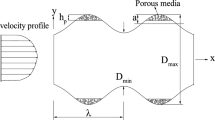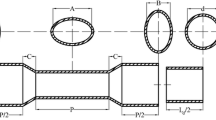Abstract
The Hartmann–Sprenger resonance tube is an acoustic device which is the basic part of acoustic igniters with no moving part or electrical spark. In this paper, effects of some design specifications on internal oscillatory flow and thermal performance of a conical Hartmann–Sprenger resonance tube are studied using both experimental and numerical methods. For numerical simulations, an implicit density-based 2D model with second-order upwind scheme is applied. To study the effects of geometrical and material specifications, a set of six different case studies with conical shapes is defined. The conical shape of the tube is selected due to its higher thermal effects and its extreme usage in thermal applications. The parameters to be changed here are pipe material, pipe length, gap distance, and the end wall condition which could be closed or perforated for hot gas extraction. Diagrams of temperature vs.entropy are plotted and compared with each other for all cases in which temperature rise is observed. The results indicated that as the gap distance changes, no oscillatory flow and no sensible temperature rise happens. A tiny hole on the tube end wall reduces the temperature inside the tube, as the shorter tube does. For longer tubes, the frequency of oscillations is proportional to the tube fundamental resonance frequency. Using materials with lower thermal conductivity in the tube wall could produce higher temperatures inside the tube. Here, maximum temperature is achieved in longer closed-end tube with lower thermal conductivity material.














Similar content being viewed by others
Notes
Total variation diminishing.
Poly tetra fluoro ethylene.
References
Hartmann J (1922) On a new method for the generation of sound waves. Phys Rev X 20:719–727
Raman G, Srinivasan K (2009) The powered resonance tube: from Hartmann’s discovery to current active flow control applications. Prog Aerosp Sci 45:97–123
Afzali B, Karimi H (2016) Numerical investigation on thermo-acoustic effects and flow characteristics in semi-conical Hartmann–Sprenger resonance tube. Proc Inst Mech Eng Part G J Aerosp Eng (online). doi:10.1177/0954410016670419
Marchan Roman A (2011) Small-scale supersonic combustion chamber with a gas-dynamic ignition system. Combust Sci Technol 183:1236–1265. doi:10.1080/00102202.2011.589874
Aref’ev KY, Voronetskii AV, Il’chenko MA (2013) Dynamic characteristics of a resonant gas-dynamic system for ignition of a fuel mixture. Combust Explos Shock Waves 49:657–661. doi:10.1134/S0010508213060038
Hongbin Gu, Li Zhi, Lihong Chen et al (2011) Characteristics of supersonic combustion with Hartmann–Sprenger Tube aided fuel injection. In: Proceedings of 17th International Space Planes and Hypersonic Systems and Technologies Conference, AIAA, San Francisco, California
Niwa M, Santana A, Kessaev K (2001) Development of a resonance igniter for GO2/kerosene ignition. J Propul Power 17:995–997
Niwa M, Santana A, Kessaev K (2001) Modular ignition system based on resonance igniter. J Propuls 17:1131–1133
Bouch GJ, Cutler AD (2003) Investigation of a Hartmann–Sprenger tube for passive heating of scramjet injectant gases. In: Proceedings of 41st Aerospace Sciences Meeting and Exhibit, AIAA, Virginia
Kreth PA, Alvi FS, Reese BM, Oates WS (2015) Control of high frequency microactuators using active structures. Smart Mater Struct 24:025030
Chaudhari K, Raman G (2010) Ultrasonic powered resonance tube actuators for flow control applications. In: Proceedings of 5th Flow Control Conference, AIAA, Chicago, Illinois
Wang L, Luo ZB, Xia ZX et al (2012) Review of actuators for high speed active flow control. Sci China Tech Sci 55:2225–2240. doi:10.1007/s11431-012-4861-2
Sarohia V, Back LH (1979) Experimental investigation of flow and heating in a resonance tube. J Fluid Mech 94:649–672
Sarohia V, Back LH, Roschke EJ, Pathasarathy SP (1976) An Experimental Investigation of Fluid Flow and Heating in Various Resonance Tube Modes. NASA Technical Report NASA-CR-148760 JPL-TM-33-780
Brocher E, Kawahashi M (1986) Wave and thermal phenomena in H–S tubes with an area constriction shock waves and shock tubes. In: Proceedings of the 15th international symposium, pp 179–185
Brocher E, Ardissone JP (1983) Heating characteristics of a new type of Hartmann–Sprenger tube. Int J Heat Fluid Flow 4:97–102
Kastner J, Samimy M (2002) Development and characterization of Hartmann tube based fluidic actuators for high speed flow control. AIAA J 40:1926–1934
Raman G, Mills A, Othman S, Kibens V (2001) Development of powered resonance tube actuators for active flow control. In: ASME FEDSM 2001
Chang SM, Lee S (2001) On the jet regurgitant mode of a resonant tube. J Sound Vib 246:567–581
Hamed A, Das K, Basu D (2002) Numerical simulation of unsteady flow in resonance tube. In: Proceedings of 40th Aerospace Sciences Meeting and Exhibit, AIAA, Virginia
Hamed A, Das K, Basu D (2003) Numerical simulation and parametric study of Hartmann–Sprenger tube based powered device. In: Proceedings of 41st Aerospace Sciences Meeting and Exhibit, AIAA, Virginia
Murugappan S, Gutmark E (2005) Parametric study of the Hartmann–Sprenger tube. Exp Fluids 38:813–823
Xia G, Li D, Merkle CL (2007) Effects of a needle on shrouded Hartmann–Sprenger tube flows. AIAA J 45:1028–1035
Tian ZF, Gong CC, Kong XP, Sun HY (2014) The experiment and simulation study of the powered resonance tube driven by annular jet. Appl Mech Mater 602–605:3013–3016
Narayanan S, Srinivasan K, Sundararajan T (2014) Aero-acoustic features of internal and external chamfered Hartmann whistles: a comparative study. J Sound Vib 333:774–787
Karimi H, Afzali B (2015) Numerical analysis of flow and heat generation mechanism in a Hartmann–Sprenger resonance tube. J Modarres Mech Eng 15:227–238 (In Persian)
Kinsler LE, Frey AR, Coppens AB, Sanders JV (1999) Fundamentals of acoustics, 4th edn. Wiley, Hoboken
Sreejith GJ, Narayanan S, Jothi TJS, Srinivasan K (2008) Studies on conical and cylindrical resonators. Appl Acoust 69:1161–1175
Scavone GP (1997) An acoustic analysis of single-reed woodwind instruments with an emphasis on design and performance issues and digital waveguide modeling techniques. Ph.D desertation, University of Stanford
Brocher E, Maresca C (1973) Etude des phenomenes thermiques dans un tube de Hartmann–Sprenger. Int J Heat Mass Transfer 16:529–538
Phillips BR, Pavli AJ (1971) Resonance tube ignition of hydrogen-oxygen mixtures. NASA Technical Note TN D6354
Author information
Authors and Affiliations
Corresponding author
Additional information
Technical Editor: Jader Barbosa Jr.
Rights and permissions
About this article
Cite this article
Afzali Khoshkbijari, B., Karimi, H. Effect of pipe geometry and material properties on flow characteristics and thermal performance of a conical Hartmann–Sprenger tube. J Braz. Soc. Mech. Sci. Eng. 39, 4489–4501 (2017). https://doi.org/10.1007/s40430-017-0843-4
Received:
Accepted:
Published:
Issue Date:
DOI: https://doi.org/10.1007/s40430-017-0843-4




